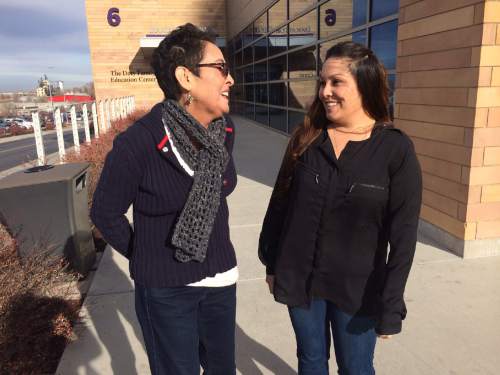This is an archived article that was published on sltrib.com in 2014, and information in the article may be outdated. It is provided only for personal research purposes and may not be reprinted.
Liver failure drained so much life from Betty Garcia that her 7-year-old granddaughter's drawings showed her horizontal: bedridden and exhausted.
She expects that to change this month, when she'll help the second-grader get ready for a Christmas pageant. She no longer needs to spend more hours sleeping than awake, she said, after receiving about half of her daughter's liver in a day-long November surgery at Intermountain Medical Center.
"I'm not tired. I don't take naps anymore," said Garcia, 52, who before the operation had lost 75 pounds in two months due to her illness. Her granddaughter is "excited that I can move around now," she said.
The hospital is hoping to make Garcia's treatment a new model. Its live liver transplant program does occasional surgeries and wants to increase to about five a year, said Michael Charlton, an Intermountain transplant hepatologist.
Live liver transplants are becoming more common nationwide, said Charlton, because they give patients in need faster access to the only organ that can regrow on its own.
Waiting to receive a liver from a deceased donor often requires patients to be close to death, added Intermountain transplant surgeon William Van der Werf.
And the wait to be selected for a donated liver, governed by national rules, can stretch over years, prompting some Utah patients to move to other states for a faster surgery.
The Intermountain team wants to provide a new option for patients. "We're hoping there are other people in the region who will see this as a possibility," Charlton said.
Doctors still don't know why Garcia's liver began quitting on her 16 years ago, she said, sending her straight home from her job as a legal technician for the city of West Jordan. She would sleep for 16 hours and go back to work.
"It was no life at all," she said.
Rachel Garcia-Trujillo, 34, told doctors she knew that giving up half of the organ could kill her — for donors, there's about a one in 200 death rate. Other serious complications can occur: Bile can leak, among other problems. While one in three volunteers have a blood type compatible for a patient in need, most hospitals require anyone who gives a liver to have a strong emotional tie to the recipient.
"The positive just outweighed the risk," said Garcia-Trujillo, who works for a division of Kennecott Utah Copper.
Van der Werf and fellow surgeon Shiro Fujita praised the daughter's decision. "It was a really brave thing that Rachel did," Van der Werf said.
Her mother had a harder time accepting the gesture. "I was more scared for her than myself," Garcia said.
Her husband, retired Kennecott worker Toby Garcia, 55, agreed. At first, he lit up when he heard his daughter was a match, he said. "But then you start thinking about the risks," he added. "She's our only child."
Since the November surgery, Garcia-Trujillo has felt like her mom once did: tired all the time.
That should subside eventually, Intermountain doctors said. They expect both women to regrow a fully working liver within a month from surgery.
Garcia says she's looking forward to regaining the stamina to take the three-hour trip to the family cabin at Flaming Gorge.
Garcia-Trujillo said she's happy that her mom won't have to miss out on any more trips to Boston or on lunch with the girls. The mother-daughter pair is planning on a low-key Christmas at home in West Valley City.
"This is our gift to our family," said Garcia-Trujillo.
Added Garcia: "And each other." —
Liver transplants in Utah
About 120 patients of Intermountain Medical Center are waiting for a new liver, said Michael Charlton, an Intermountain transplant hepatologist. The most recent federal data shows nearly 200 patients on the waiting list in Utah.
In the past five years, Intermountain has done 139 adult liver transplants. Meanwhile, Primary Children's Hospital has logged 61 pediatric liver transplants. Seven of those transplanted livers came from living donors.
The University of Utah's health care system does 36 transplants per year and about 75 patients are currently on the waiting list. Both networks draw patients from Wyoming, Idaho and Montana for the complicated procedures. Both networks draw patients from Wyoming, Idaho and Montana for the complicated procedures.



